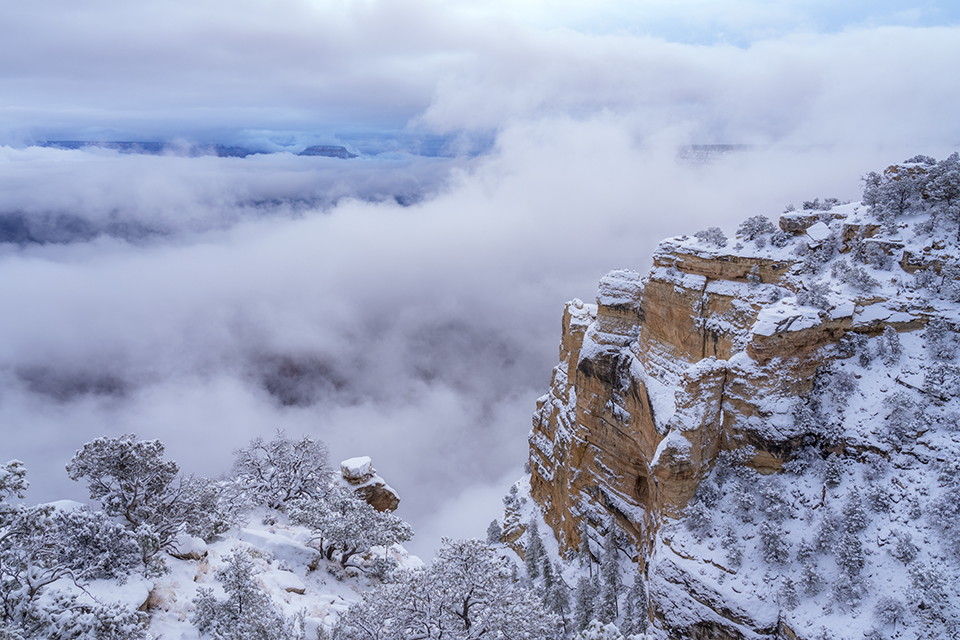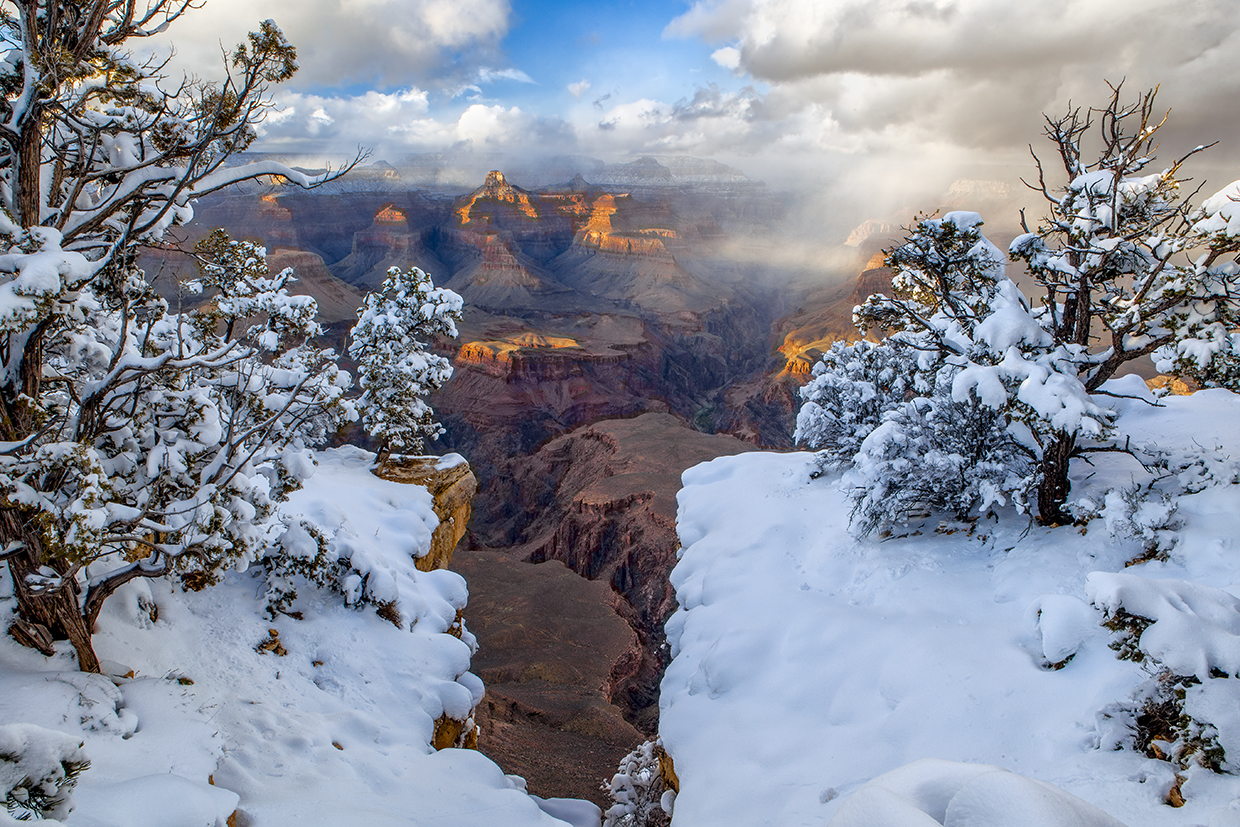Editor’s Note: If you’ve been following along with us this year, you might have noticed, and maybe even read, some of the flashback pieces we’ve published to celebrate our 100th anniversary. This month, we’re at it again with a story by Norman G. Wallace, who made his debut in August 1932. Not as a writer, though. As a photographer. He was exceptional at both, but neither paid his mortgage. He was a civil engineer for the Arizona Highway Department. That was his day job. Writing and photography were just hobbies, and we were the beneficiary. In April, Mr. Wallace joined 14 others in the inaugural class of the Arizona Highways Hall of Fame.
Centuries ago, the sun went down in the fast-gathering haze of a winter afternoon on the Coconino Plateau. A deer walked softly through the long shadows of the big pines and across the pinkish sunlit patches of the first snow of the dying year. As the sun disappeared in the murky red of the western sky, a soft wind from the depths of the Canyon brought the low roar of the river as it gnawed its way through the bottommost depths of the Granite Gorge.
The wind died away momentarily — and with it the faint murmurs of the river at work — and then came back to life with a new and louder voice of that mighty force, never-ending in its grinding and tearing labors to get back to the sea.
A huge slab of rock, loosened by the frost of centuries and undercut by the rains of a thousand summers, gently moved downward from its resting place of a hundred million years — slowly at first, and then with increasing speed it slid and bounced from ledge to ledge and then fell into space, over cliffs of immense heights, into the abysmal depths. Trees, rocks and dirt followed its destroying march. And its thunderous roar as it disappeared in the depths of the Canyon did not cease for many minutes, even smothering the challenging growl of the river far below. Absolute quiet followed, and again the victorious voice of the river rose with the increasing wind as it swept upward from the depths.

Long had night fallen before that slab reached its goal thousands of feet below its old home on the upper rim, and the gentle snow flurries had long covered the new gash in the Canyon’s edge. The wind now roared among the pines at the Canyon’s edge, as did the surf of the ancient ocean whose shore once lay where the limestone and sandstone cliffs of the Canyon now rear to thousands of feet above its origin. The snow danced in whirlwinds of joy or fell softly as it piled higher and higher between the pine trees or blanketed the evergreen boughs with its white, cotton-like balls. Far away, on the other side of the Earth, lowly shepherds followed a bright star as it crossed the heavens and came to rest over the manger where a gentle spirit was born.
Centuries of winter frost and summer cloudbursts follow. The deer cross the open spaces between the pine trees for generations without end. Other huge slabs of rock give way to frost and gravitation as they fall into the depths, and the river goes to work upon them the instant their downward path has ceased. The river roars and rumbles in its joy at finding new work to do. Although each fallen rock has left its mark on the sides of the Canyon, and each gash a new sear, for centuries without end, the shape and outline of the Canyon’s edge are not altered to the eye, so little does the never-ending erosion of the Canyon’s walls change the general aspect as seen from the rim.
There are many different impressions on the human mind made by the Grand Canyon, depending upon the time of the year and the conditions under which the observer beholds it for the first time. The scene at the Canyon to most everyone is one of sunshine and shadow. Day after day of cloudless skies and blue-purple shadows between the red walls and side canyons entertain the visitors who hop off of one train and catch the next one back to civilization.
However, it is the writer’s opinion that the time to see the Canyon is during the exhibition by old Mother Nature of her odd moods. Wintertime at the Canyon is especially scenic to those who have never seen it, and time should be taken to allow Nature to go through with her act, should she be putting one on at the time. For instance, between Christmas and New Year’s of this winter, a storm came over the Coconino Plateau from the west during the night.

The next morning, snow and gray fog hid the depths of the Canyon as seen from the El Tovar Hotel. Passengers getting off of the early morning train, and expecting to gaze into the depths of the Canyon for the first time, were greeted by a gray void beyond the rim. Nothing was seen of the tremendous depths below the rim. But the presence of that abyss could be plainly felt, although invisible. Disappointment was voiced by those whose schedule called for a return to civilization on the night train. Those accustomed to the whims of Nature told these visitors to be patient for the rest of the day. Perhaps Nature might put on a show.
As the snow stopped and a slight wind blew the fog away in patches from the upper rim, point by point became visible, sticking their sharp edges out of the mist — like gray battleships coming into harbor from out at sea. Curling wisps of moisture rose from far below and hung around the snow-clad benches between the cliffs below, then curled around jutting points to disappear into the side canyons.
Far up in the Bright Angel Canyon toward the North Rim, a small snowstorm still raged, with curling and dancing clouds of white enveloping the temples and capes of the Kaibab. Then out came the sun, transforming all to a fairyland of white at the top of the Canyon and bringing out the intricate and massive sides of the Canyon’s walls one by one until the entire Canyon was revealed to the eye.
Blue haze and red walls and purple gorges on every side. The snow does not go more than a thousand feet below the rim, and the green pines, snow clad, point upward from their precarious foothold on the very edges of the chasm, or from the steep slopes below the rim.
At this time, the visitor takes the side automobile trip eastward to the watchtower at Desert View — 25 miles away over the snow-covered pavement. As Grandview is neared, the depth of snow is more noticeable as the road curves among the snow-clad pines and cedars. Christmas trees abound on every hand, trees whose icy, crystal-like branches reflect the bright sunshine as it is lighted by a million small electric lights, and whose white-festooned twigs each bear the snow of Nature’s latest act. The road, while snow-covered to a depth of 6 inches or so, is perfectly safe with careful driving. Vista after vista opens out as the straightaways unfold before the windshield. A group of deer, which had huddled together in the manzanita brush during the storm, come out into the open and begin to browse on the twigs. White clouds in a blue firmament drift by as the sunshine reflects in the millions of diamond-like snow crystals at the side of the road.

Desert View at last, and the red and blue Painted Desert far beyond the snow-covered nearby pine-clad slopes is revealed. Far to the north, Navajo Mountain, the ancient home of the Indians, looms out in a blue dome above the horizon. The Kaibab Plateau across the Canyon, white and frozen, is silent and alone. A cloud of mist-like snow and smoky vapor, faintly seen in the blue distance, streaks down the sides of the gorge as one more slab loosened by the frost falls to the bottom in a roar of sound and chaos of flying rock and trees. One more gash in the Canyon’s side, and one more windborne rumble of the river as it tears into its work of carrying that new load to the ocean.
A deer walks across the new-fallen snow among the pink sunlit patches between the pines as the sun sinks below the treetops and another winter night — frosty, clear and starlit — sets in. There was no beginning, and there seems to be no end. The river’s voice rises with the soft wind and ceases, as it has done ever since the dim and distant past.
Its work is never completed, and it will never cease until the end of the world, and time itself, ceases.


